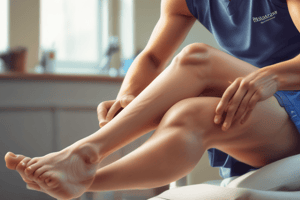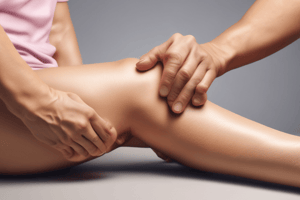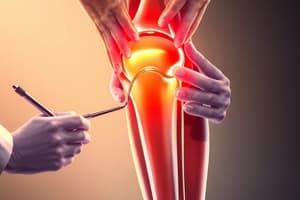Podcast
Questions and Answers
What is the primary role of the patella in the knee complex?
What is the primary role of the patella in the knee complex?
- To redirect force exerted by the quadriceps (correct)
- To provide joint stability
- To connect the femur and tibia directly
- To alleviate compressive stress during extension
Which statement about the knee's muscular anatomy is true?
Which statement about the knee's muscular anatomy is true?
- The patellar tendon originates at the superior pole of the patella.
- The rectus femoris originates from the ASIS. (correct)
- The quadriceps tendon originates from the femoral shaft.
- Vastus lateralis, intermedius, and medialis insert on the tibial tuberosity.
What is the maximum compressive stress experienced on the patellofemoral joint?
What is the maximum compressive stress experienced on the patellofemoral joint?
- When squatting with the knee at 90º (correct)
- During rapid leg movement
- At full knee extension
- While walking
Which of the following structures contributes to the stability of the knee joint posteriorly?
Which of the following structures contributes to the stability of the knee joint posteriorly?
Which ligament is NOT involved in providing stability to the knee joint?
Which ligament is NOT involved in providing stability to the knee joint?
How is the knee joint capsule characterized?
How is the knee joint capsule characterized?
What types of injury mechanisms can lead to knee joint problems?
What types of injury mechanisms can lead to knee joint problems?
What should be included in the examination questions specific to the knee joint?
What should be included in the examination questions specific to the knee joint?
What is a key characteristic of Osgood-Schlatter's disease?
What is a key characteristic of Osgood-Schlatter's disease?
Which statement accurately describes the screw-home mechanism of the knee?
Which statement accurately describes the screw-home mechanism of the knee?
In terms of muscle testing considerations, which method is recognized for avoiding over-grading?
In terms of muscle testing considerations, which method is recognized for avoiding over-grading?
What is the capsular pattern of the knee?
What is the capsular pattern of the knee?
What is one potential outcome of active tibial rotation at 90º of flexion?
What is one potential outcome of active tibial rotation at 90º of flexion?
Which statement about the knee's osteokinematics is correct?
Which statement about the knee's osteokinematics is correct?
What aspect of knee extension strength is emphasized in assessment?
What aspect of knee extension strength is emphasized in assessment?
Which muscle groups are primarily involved in knee flexion?
Which muscle groups are primarily involved in knee flexion?
Flashcards
Knee Examination
Knee Examination
A structured assessment of the knee joint, considering its anatomy, biomechanics, and patient history.
Subjective Knee Information
Subjective Knee Information
Patient-reported details including mechanism of injury, swelling, instability, joint sounds, and pain triggers.
Knee Joint Stability
Knee Joint Stability
Maintained by ligaments, tendons, and muscles surrounding the knee joint, ensuring proper function.
Knee Extensor Mechanism
Knee Extensor Mechanism
Signup and view all the flashcards
Patellofemoral Joint
Patellofemoral Joint
Signup and view all the flashcards
Knee Biomechanics
Knee Biomechanics
Signup and view all the flashcards
Mechanism of Injury
Mechanism of Injury
Signup and view all the flashcards
Tibiofemoral Joint
Tibiofemoral Joint
Signup and view all the flashcards
Patella Function
Patella Function
Signup and view all the flashcards
Osgood-Schlatter Disease
Osgood-Schlatter Disease
Signup and view all the flashcards
Knee Extension Strength
Knee Extension Strength
Signup and view all the flashcards
Knee Flexion Muscles
Knee Flexion Muscles
Signup and view all the flashcards
Knee Degrees of Freedom
Knee Degrees of Freedom
Signup and view all the flashcards
Knee Joint Congruency
Knee Joint Congruency
Signup and view all the flashcards
Locking Mechanism
Locking Mechanism
Signup and view all the flashcards
Functional Knee Assessment
Functional Knee Assessment
Signup and view all the flashcards
Study Notes
Examination Considerations of the Knee
- Objectives: Discuss relevant knee anatomy, pertinent subjective information, proper examination techniques, and pathological considerations.
- Subjective – Mechanism of Injury: Distinguish between traumatic (e.g., sports injury) and atraumatic (e.g., overuse) mechanisms.
- Examination Questions: Crucial questions include: mechanism of injury, swelling, instability, joint sounds, aggravating/alleviating factors, and any other relevant details.
- Bony Anatomy:
- Tibiafemoral joint: Includes anterior and posterior cruciate ligaments, medial and lateral condyles, collateral ligaments, and menisci.
- Patellofemoral joint: Involves the patella, femur, and related ligaments and tendons.
- Tibiofibular joint (proximal): Involves the fibula, tibia, and collateral ligaments.
- Structure and Function:
- Stability: Provided by quadriceps tendon, patellar ligament, expansions from quadriceps (anterior); medial and lateral collateral ligaments, ITB, pes anserinus insertion (medial/lateral); hamstrings, gastrocnemius, ACL, and PCL (posterior).
- Joint Capsule: Synovial, large and loose, reinforced by tendons and muscle expansions.
- Muscular Anatomy: Includes vastus lateralis, vastus intermedius, vastus medialis, quadriceps tendon, iliotibial band, lateral retinaculum, semitendinosus, semimembranosus, biceps femoris, gracilis, plantaris, and gastrocnemius.
- Knee Extensor Mechanism:
- Origin: Rectus femoris from ASIS, vastus muscles from the femoral shaft.
- Insertion: Quadriceps tendon to superior pole of the patella, patellar tendon to tibial tuberosity.
- Function: Redirects quadriceps force, creating large compressive stress on patellofemoral joint.
- Maximum Compression: Occurs when knee is at 90 degrees with foot planted, potential up to 7x body weight in squatting.
- Intercondylar Groove: Important for patellar articulation.
- Clinical Considerations (Osgood-Schlatter's "Disease"):
- Also known as tibial tuberosity apophysitis.
- Affects adolescents (8-15 years old), with females often presenting earlier than males.
- Pain localized over the tibial tuberosity, with possible swelling or a "bump."
- Radiographic Features: Radiographic features of anterior tibial tuberosity development. Example of different ages shown.
- Osteokinematics:
- Two degrees of freedom: flexion/extension and internal/external rotation.
- Incongruity and asymmetry of articular surfaces.
- "Screw-home" mechanism: last 10-15 degrees of knee extension (involuntary).
- Active tibial rotation possible at 90 degrees of flexion (15-30 degrees).
- Capsular Pattern: Flexion is greater than extension.
- Knee Extension Muscle Testing: Quadriceps strength is significant; avoid overgrading by using a dynamometer or a 1-RepMax leg press.
- Comparison of Four Quadriceps Strength Tests: Single leg sit-to-stand is most predictive of L3 radiculopathy. Tests include single leg sit-stand, step-up, and knee-flexed/extended MMT.
- Knee Flexion Muscle Testing: Medial hamstrings create internal tibial rotation; lateral hamstrings create external tibial rotation.
- Other Considerations: Evaluate hip and foot/ankle complex, functional movements/limitations, and have patients demonstrate their movements.
- Practice! Emphasize good practice.
Studying That Suits You
Use AI to generate personalized quizzes and flashcards to suit your learning preferences.




